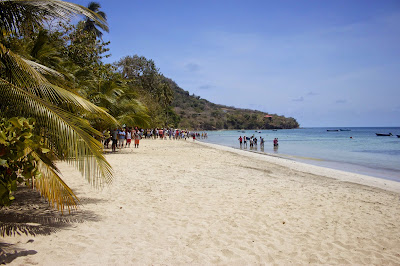As the darkness embraces the island of
Providence and the temperatures settle to a more manageable warm embrace, the
people return to their front porches, swing in their hammocks, cook their
dinners and crack open a beer or two. But in the forested hills of Providence’s
interior something is stirring.
You hear it first, a rustling of leaves
followed by the scratchy tickling of needled toes on concrete. The volume
grows, more rustling more clicking until it reaches a crescendo of a thousand
ticking clocks all out of sync. Like a forest of cicadas or a thousand Fonzies,
this is a metronomic army on the march.
Then the smell hits you, of rotting mulch
with a whiff of putrifying fish guts. But it’s not umpleasant, quite sweet, the
smell of action.
And then you see them, dozens at first, then
hundreds and by midnight thousands. A two way procession, mothers laden with
eggs marching determinedly towards the sea and those who’s mission is complete
climbing back up the banks and rock outcrops returning to the hills.
These are the infamous black mountain crabs of
Providence. Every year when the first small showers arrive between April and
June they leave their mountain retreats and head to the see driven by the need
to reproduce. The females carry their eggs under their bodies. Males loiter
attempting to fertilise the eggs during the females migration to the sea.
Their major obstruction is Providence’s
single road which encircles the island with its high curbstones and occasional
traffic. As a car or bike approaches the swarming marching army scuttles in a
wave to avoid the wheels of doom! Many islanders are conscious of the crabs,
which provide a livelihood to many as they are eaten most of the year, and slow
their charges to avoid the black mass. But some do not. The squashed crabs do
not go to waste. The hungry mothers dine on the flesh as they re-cross the road
on their return to the mountains. In the daylight chickens will feed on those bodies
that remain.
As your eyes grow accustomed to the dark you
notice the banks on the side of the road contain a thriving mass of moving
shiny shells rustling their way through the leaves. But the road resembles a
battleground, the wounded, dead and dying litter the road, the opportunist
cannibals feed as they pass.
We felt most humbled to witness this amazing
migration, to experience the drive that these crabs most feel in order to
undertake such a mammoth journey to ensure of their species own survival.
However we also felt horrified at the
numbers squashed by careless and ignorant people, many of whom rely on the crab
for an income or at least have friends and family that do. The islanders are
trying to protect these animals. Road blocks are set up during the migration
and people are encouraged not to collect crabs, particularly those with eggs.
We are hopeful for the future as people become better educated and aware so
that future generations can experience one of natures amazing events.
Say Hello to the Black Mountain Crab
Emerging from the forest through the leaf litter and on to the road
A steady clicking and ticking of needle like toes
As the night progresses the numbers boom
The high curbstones provide yet another obstacle
Although called black their shells are more of a deep purple
8 legs is an advantage for climbing
Often they cross the road near street lights which I think must confuse them
This one is definitely confused
They swarm around and into any building in their way
Home owners are for ever sweeping out their houses in the morning to remove the squatters
A chance meal for the long return trip
Although this one may have just fainted!
Stop! Crabs crossing
















































